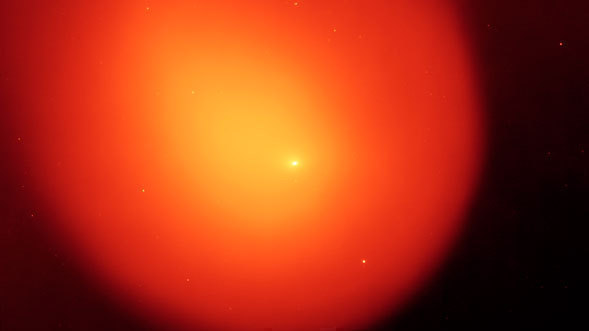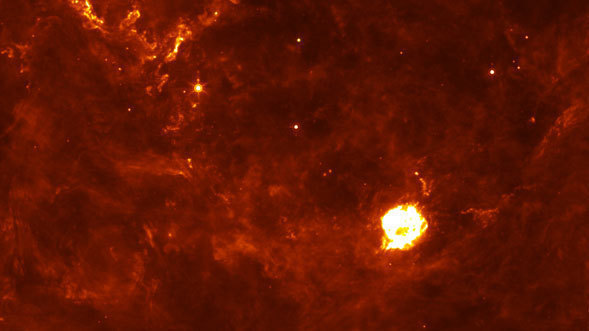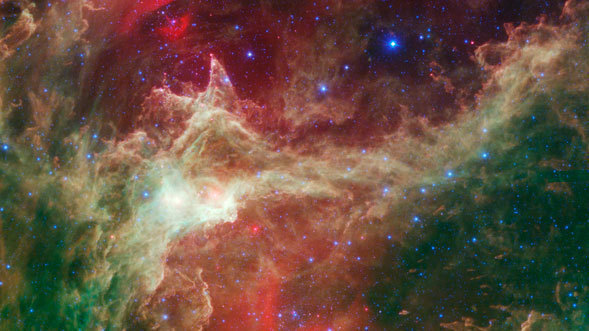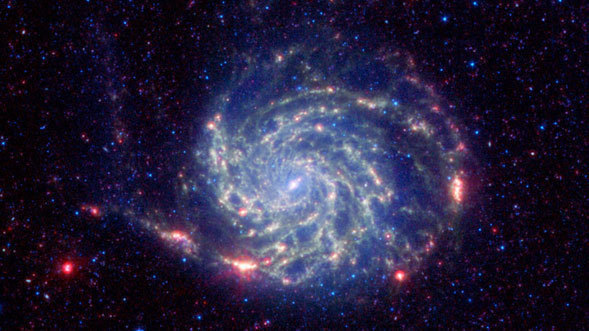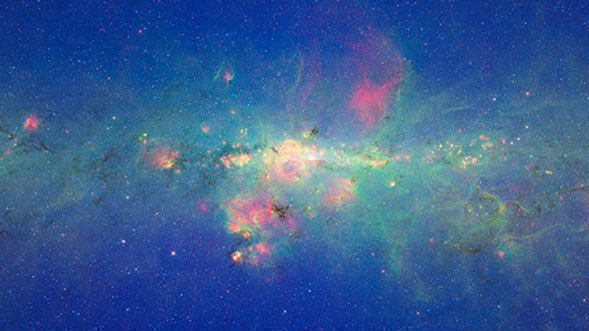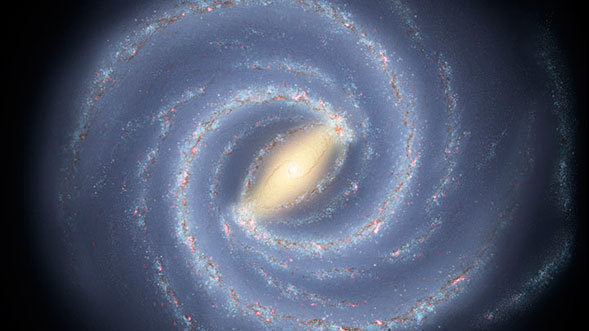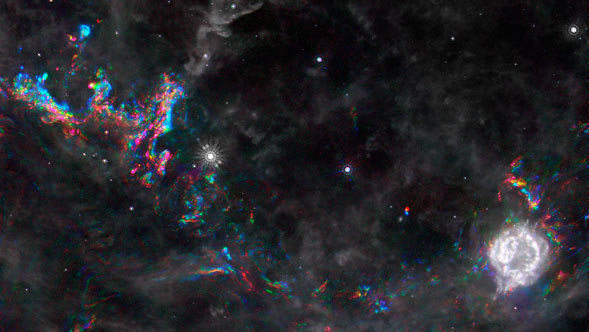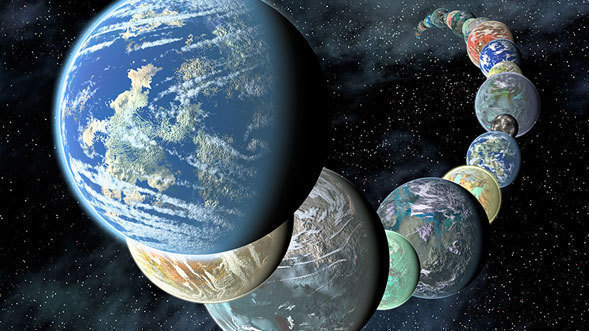Displaying news 301 - 330 of 516 in total
When comet Holmes unexpectedly erupted in 2007, professional and amateur astronomers around the world turned their telescopes toward the spectacular event. Their quest was to find out why the comet had suddenly exploded.
This painterly portrait of a star-forming cloud, called NGC 346, is a combination of multiwavelength light from NASA's Spitzer Space Telescope (infrared), the European Southern Observatory's New Technology Telescope (visible), and the European Space Agency's XMM-Newton space telescope (X-ray).
Our current view of the universe, to quote Albert Einstein, is "not weirder than we do imagine, but weirder than we can imagine." That said, we have no choice but to observe the universe through human eyes and brains. How can we even start to make sense of it?
RCW 108 is a region where stars are actively forming within the Milky Way galaxy about 4,000 light years from Earth. This is a complicated region that contains young star clusters, including one that is deeply embedded in a cloud of molecular hydrogen. By using data from different telescopes, astronomers determined that star birth in this region is being triggered by the effect of nearby, massive young stars.
Hot spots near the shattered remains of an exploded star are echoing the blast's first moments, say scientists using data from NASA's Spitzer Space Telescope.
Podcasting -- producing audio & video content for computers and mobile devices -- has grown in popularity over the past several years. NASA's Spitzer Space Telescope hit a new milestone in August: 7 million downloads of its various podcasts.
Water is being blasted to pieces by a young star's laser-like jets, according to new observations from NASA's Spitzer Space Telescope.
Take leading artists and scientists from all over the Pasadena area, put them in the great outdoors on a lovely late summer evening, and you've got TERRA-BYTE, an interactive celebration of art and science a the Los Angeles Arboretum. Combining "TERRA" as in the planet earth and "BYTE" a unit of storage in computers, TERRA-BYTE creates a platform to explore the natural world through art, science, and emerging technology within the beautiful gardens of The Arboretum. From 5:30 to 9:30 pm, this Sunday, 9/14/2008, visitors will enjoy live music, garden tours, refreshments and interactive exhibits including an infrared camera at the Spitzer Space Telescope booth.
A new image from NASA's Spitzer Space Telescope tells a tale of life and death amidst a rich family history. The striking infrared picture shows a colorful cosmic cloud, called W5, studded with multiple generations of blazing stars.
Los Angeles' Griffith Observatory will host an event on August 22-24, 2008 to celebrate the fifth anniversary of NASA's Spitzer Space Telescope. The Spitzer mission has shown us incredible new views of the universe in infrared light, which can be thought of as "night vision" or "heat" light. Spitzer's accomplishments include imaging the farthest galaxy yet seen, multiple breakthroughs in our understanding of the lives of stars and the first detection of light coming from planets orbiting other stars.
New evidence from NASA's Spitzer Space Telescope reveals that most galaxies undergo a huge stellar baby boom when they first enter a "cosmic city", or galaxy cluster. And the more distant the galaxy cluster, the greater the star formation rate.
The Pinwheel galaxy is gussied up in infrared light in a new picture from NASA's Spitzer Space Telescope.
A contender for the title of brightest star in our Milky Way galaxy has been unearthed in the dusty metropolis of the galaxy's center. The Spitzer Space Telescope is a NASA mission managed by the Jet Propulsion Laboratory. This website is maintained by the Spitzer Science Center, located on the campus of the California Institute of Technology and part of NASA's Infrared Processing and Analysis Center. Privacy Policy
Astronomers have uncovered an extreme stellar machine -- a galaxy in the very remote universe pumping out stars at a surprising rate of up to 4,000 per year.
When amateur astronomer Ron Arbour spotted an enormous explosion from 17 million light-years away in the Fireworks Galaxy (NGC 6946), many professional scientists believed that it was the final death throes of a massive dying star. However, observations from NASA's Spitzer Space Telescope unexpectedly showed that a relatively lightweight star was the source of this spectacular blast.
More than 800,000 snapshots from NASA's Spitzer Space Telescope have been stitched together to create a new "coming of age" portrait of stars in our inner Milky Way galaxy.
New images from NASA's Spitzer Space Telescope are shedding light on the true structure of the Milky Way, revealing that it has just two major arms of stars instead of the four it was previously thought to possess.
Astronomers have unearthed secrets from the grave of a star that blasted apart in a supernova explosion long ago. By decoding ghostly echoes of light traveling away from the remains of a supernova called Cassiopeia A, the scientists have pieced together what the star looked like in life, and ultimately how it met its demise.
NASA's Spitzer Space Telescope has found a bizarre ring of material around the magnetic remains of a star that blasted to smithereens.
On Earth, neon is known for being flashy. Any Las Vegas tourist knows that signs sporting this noble gas are hard to miss, but in space this is not always true. Neon is the fifth most abundant element in the cosmos, but until recently, astronomers couldn't seem to get a precise measurement of it in the Universe.
The incredible images from NASA's "Great Observatories" and many other NASA space- and ground-based telescopes are now available to the public in an educational and innovative manner through the release of the free WorldWide Telescope software from Microsoft.
When it comes to giving birth, galaxies don't seem to have a "ticking biological clock." In fact, observations from NASA's Spitzer Space Telescope show that old galaxies were the biggest producers of new stars when our universe was half of its current age of 13.6 billion years.
Millions of clustered stars glisten like an iridescent opal in a new image from NASA's Spitzer Space Telescope.
The universe's first "galactic cities" did not sprout up randomly across space. On the contrary, a new statistical analysis of observations from NASA's Spitzer Space Telescope confirms that these ancient galactic metropolises may have developed much like sprawling cities joining together into a larger urban whole.
Millions of faint galaxies are hovering near the edge of our universe, too dim to be detected by most telescopes -- but some huge cosmic explosions and the supersensitive infrared eyes of NASA's Spitzer Space Telescope are bringing many of these muted galaxies to light.
Researchers using NASA's Spitzer Space Telescope have discovered large amounts of simple organic gases and water vapor in a possible planet-forming region around an infant star, along with evidence that these molecules were created there. They've also found water in the same zone around two other young stars.
Diamonds may be rare on Earth, but surprisingly common in space -- and the super-sensitive infrared eyes of NASA's Spitzer Space Telescope are perfect for scouting them, say scientists at the NASA Ames Research Center in Moffett Field, Calif.
Astronomers have discovered that terrestrial planets might form around many, if not most, of the nearby sun-like stars in our galaxy. These new results suggest that worlds with potential for life might be more common than we thought.
NASA's Hubble and Spitzer space telescopes, with a boost from a natural "zoom lens," have uncovered what may be one of the youngest and brightest galaxies ever seen in the middle of the cosmic "dark ages," just 700 million years after the beginning of our universe.
Newborn stars peek out from beneath their natal blanket of dust in this dynamic image of the Rho Ophiuchi dark cloud from NASA's Spitzer Space Telescope.
Displaying news 301 - 330 of 516 in total
